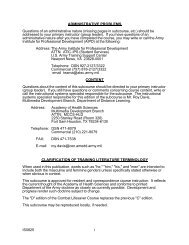MCWP-3-11.3-Scouting-and-Patrolling
MCWP-3-11.3-Scouting-and-Patrolling
MCWP-3-11.3-Scouting-and-Patrolling
You also want an ePaper? Increase the reach of your titles
YUMPU automatically turns print PDFs into web optimized ePapers that Google loves.
<strong>Scouting</strong> <strong>and</strong> <strong>Patrolling</strong> __________________________________________________________________________________ D-3“T” FormationIn the “T” shaped formation, the assault element isdeployed across (perpendicular to) the enemy’s routeof movement so that its position forms the crossing ofa “T” at the top. (See fig. D-7.)opposite direction. The attack of the enemy approachingfrom either direction requires only that everysecond man may shift to the opposite side of the formation.Each man fires only to his front <strong>and</strong> only whenthe enemy is at a very close range. Attack is by fireonly <strong>and</strong> each man keeps the enemy under fire as longas it remains to his front.If the enemy attempts to escape in either directionalong the killing zone, each Marine takes the enemyunder fire as the enemy comes into the Marine’s sectorof fire. The “T” formation is very effective at haltinginfiltration. But it has one chief disadvantage; there isa possibility that the ambush will engage a superiorforce at night while spread out. (See fig. D-8.)Figure D-8. “T” Formation (Target Approachingfrom Either Direction).The “V” FormationFigure D-7. “T” Formation.This formation can be used day or night to establish anambush to interdict movement through open areas thatare hard to seal off.A small force can use the “T” formation to harass,slow, <strong>and</strong> disorganize a larger force. When the leadelements of the enemy are engaged, they will normallyattempt to maneuver right or left to close with theambush. Mines <strong>and</strong> other obstacles placed to theflanks of the killing zones slow the enemy’s movements<strong>and</strong> permit the ambush force to deliver heavyfire <strong>and</strong> withdraw without becoming decisivelyengaged.The “T” formation can be used to interdict smallgroups attempting night movement across open areas.For example, the assault element is deployed along anavenue of approach with every second man facing theThe “V” shaped formation is deployed along bothsides of the enemy’s route of movement so that itforms a “V”; care is taken to ensure that neither group(within the “V”) fires into the other.This formation subjects the enemy to both enfilading<strong>and</strong> interlocking fire. The “V” formation is best suitedfor fairly open terrain but can also be used in closeterrain. When established in close terrain, the legs ofthe “V” close in as the lead element of the enemy forceapproaches the apex of the “V”, <strong>and</strong> opens fire at aclose range.Here, even more than in open terrain, all movement<strong>and</strong> fire must be carefully coordinated <strong>and</strong> controlledto ensure that the fire of one wing does not endangerthe other wing. The wider separation of forces makesthis formation difficult to control, <strong>and</strong> there are fewsites that favor its use. Its main advantage is that it is



